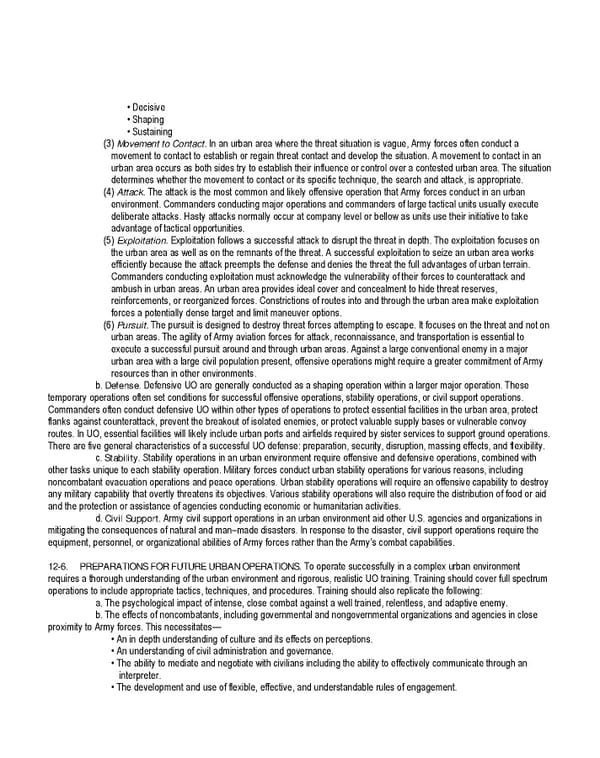• Decisive • Shaping • Sustaining (3) Movement to Contact. In an urban area where the threat situation is vague, Army forces often conduct a movement to contact to establish or regain threat contact and develop the situation. A movement to contact in an urban area occurs as both sides try to establish their influence or control over a contested urban area. The situation determines whether the movement to contact or its specific technique, the search and attack, is appropriate. (4) Attack. The attack is the most common and likely offensive operation that Army forces conduct in an urban environment. Commanders conducting major operations and commanders of large tactical units usually execute deliberate attacks. Hasty attacks normally occur at company level or bellow as units use their initiative to take advantage of tactical opportunities. (5) Exploitation. Exploitation follows a successful attack to disrupt the threat in depth. The exploitation focuses on the urban area as well as on the remnants of the threat. A successful exploitation to seize an urban area works efficiently because the attack preempts the defense and denies the threat the full advantages of urban terrain. Commanders conducting exploitation must acknowledge the vulnerability of their forces to counterattack and ambush in urban areas. An urban area provides ideal cover and concealment to hide threat reserves, reinforcements, or reorganized forces. Constrictions of routes into and through the urban area make exploitation forces a potentially dense target and limit maneuver options. (6) Pursuit. The pursuit is designed to destroy threat forces attempting to escape. It focuses on the threat and not on urban areas. The agility of Army aviation forces for attack, reconnaissance, and transportation is essential to execute a successful pursuit around and through urban areas. Against a large conventional enemy in a major urban area with a large civil population present, offensive operations might require a greater commitment of Army resources than in other environments. b. Defense. Defensive UO are generally conducted as a shaping operation within a larger major operation. These temporary operations often set conditions for successful offensive operations, stability operations, or civil support operations. Commanders often conduct defensive UO within other types of operations to protect essential facilities in the urban area, protect flanks against counterattack, prevent the breakout of isolated enemies, or protect valuable supply bases or vulnerable convoy routes. In UO, essential facilities will likely include urban ports and airfields required by sister services to support ground operations. There are five general characteristics of a successful UO defense: preparation, security, disruption, massing effects, and flexibility. c. Stability. Stability operations in an urban environment require offensive and defensive operations, combined with other tasks unique to each stability operation. Military forces conduct urban stability operations for various reasons, including noncombatant evacuation operations and peace operations. Urban stability operations will require an offensive capability to destroy any military capability that overtly threatens its objectives. Various stability operations will also require the distribution of food or aid and the protection or assistance of agencies conducting economic or humanitarian activities. d. Civil Support. Army civil support operations in an urban environment aid other U.S. agencies and organizations in mitigating the consequences of natural and man–made disasters. In response to the disaster, civil support operations require the equipment, personnel, or organizational abilities of Army forces rather than the Army’s combat capabilities. 12-6. PREPARATIONS FOR FUTURE URBAN OPERATIONS. To operate successfully in a complex urban environment requires a thorough understanding of the urban environment and rigorous, realistic UO training. Training should cover full spectrum operations to include appropriate tactics, techniques, and procedures. Training should also replicate the following: a. The psychological impact of intense, close combat against a well trained, relentless, and adaptive enemy. b. The effects of noncombatants, including governmental and nongovernmental organizations and agencies in close proximity to Army forces. This necessitates— • An in depth understanding of culture and its effects on perceptions. • An understanding of civil administration and governance. • The ability to mediate and negotiate with civilians including the ability to effectively communicate through an interpreter. • The development and use of flexible, effective, and understandable rules of engagement.
 Ranger Handbook Page 225 Page 227
Ranger Handbook Page 225 Page 227